
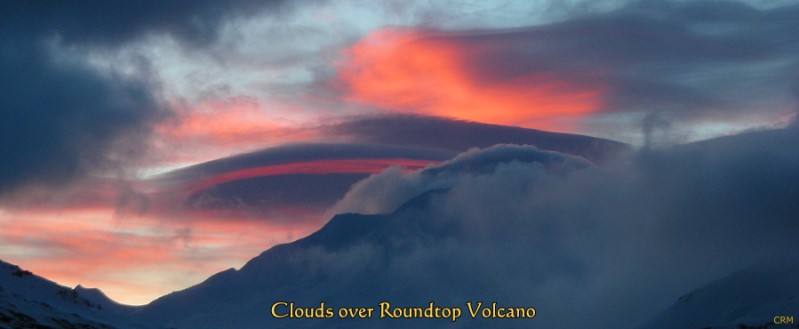
The Aleutian Low is one of the principal causal factors of the weather and climate in the Unimak region. The Aleutian low is "A region of generally low pressure located near the Aleutian Islands, where sub-polar cyclones reach their maximum intensity. This feature also encompasses non-stationary systems of both low and high pressure (cyclones and anticyclones) that form and dissipate along fronts and rapidly move in a broad sub-polar band of west-to-east flowing air currents widely known as the prevailing westerlies.
The Aleutian Low shifts position and changes in intensity with the seasons. During the winter, it is located farther south, and is large, semi-permanent, and most intense. During the summer, it is located farther north, and is small and impermanent to nonexistent.
While not a dynamically directly-driven feature, the Aleutian Low still serves as a useful proxy for storm activity. Its position and size can be shown to be correlated with major indices such as ENSO, and in this manner it conveniently represents a mechanism for assessing impacts from teleconnection patterns."1
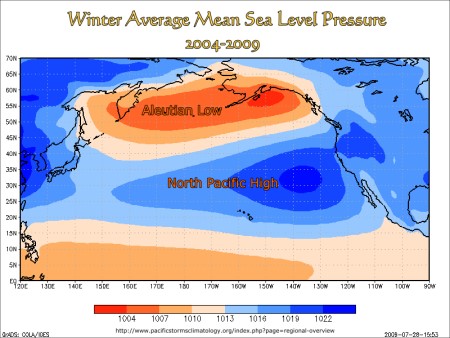
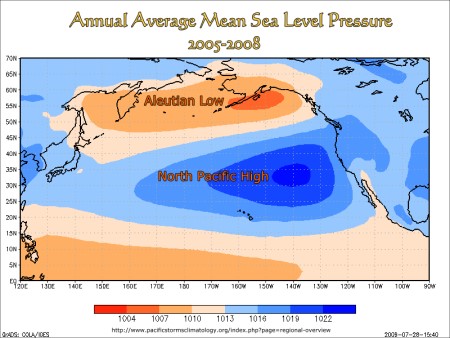
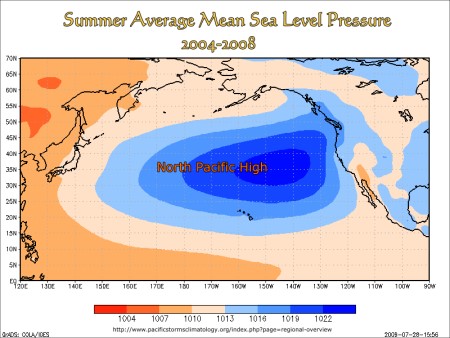
The Aleutian Low's location and intensity is shown in the above three maps in relation to the stationary North Pacific High that lies to the south. The Aleutian Low is found in the area where the relatively warm waters of the south meet the colder waters to the north. This is also the zone where the colder air from the subarctic meets the warmer moist air to the south. This creates a large band of atmospheric instability with rising moist air that stretches from the Kamchatka Peninsula in the west and all the Aleutian Islands chain.
The "Cradle of the Storms" is the colloquial name for the Aleutian Low area because this is the stormiest area in the north Pacific.2 These cyclonic storms generally travel eastward along the Aleutians in the zone of the westerly winds. The strongest of these storms may make their way to the west coast of North American during the winter and then move across the mid section of the U.S..
The Aleutian Low storm tracks are shown in the map to the right. The map shows that the weaker Aleutian Lows (AL) often move into the western Bering Sea. The stronger ALs generally move eastward south of the Aleutian Islands. Some of these ALs stagnate and weaken in the Gulf of Alaska but then move to the southeast or onto the continent.3
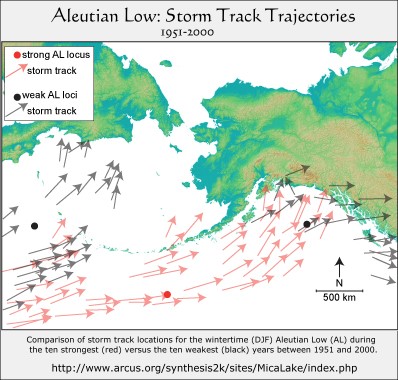
The Unimak Area of Alaska shows very small seasonal changes in temperature, as seen in the map to the right. The average temperature difference between July and January is only about 10 degrees F.
The moderating influence of the marine environment is the primary reason for this small temperature difference. Since this area is in the zone of the westerly winds, moist air and relatively warm temperatures come into the area after having traveled over extensive ocean areas. This means that the Unimak Area is generally free from winter incursions of cold air from the Alaska mainland and only occasionally does cold Siberian area make its way across the Bering Sea to the Aleutian Islands, although in particularly cold winters this does happen. During such cold winters, the Bering Sea can be covered with ice as far as Isanotski Strait and cold Siberian air can drive the temperatures down to near zero.
Summer temperatures are also moderated by the strong marine environment so that daytime highs seldom surpass 70 degrees F. Temperature extremes increase as one travels up the Alaska Peninsula, so that Cold Bay is slightly colder in winter and warmer in summer than Unimak Island.
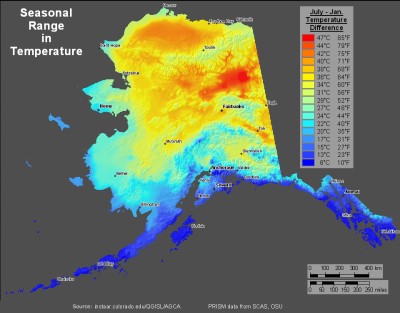
The maximum Ice Extent in the Bering Sea is shown in the maps to the right. Although extensive data doesn't seem to be available on the southern extent of Bering Sea ice, the available data and anecdotal evidence indicates that the sea ice edge seldom goes beyond Isanotski Strait and rarely as far as Unimak Pass.
Ice in the southern Bering Sea that extends as far as Isanotski Strait has a general chilling effect on temperatures in winter since the moderating effect of open water is gone. Winds and tides can bring drift ice from the edge of the Bering Sea ice pack into Isanotski Strait and as far south as Ikatan Bay. Below is a picture of ice filling Isanotski Strait in False Pass.4
Amak Island lies just off shore from Isanotski Strait in the Bering Sea and it was historically a walrus hauled out, indicating that the edge of the Bering Sea ice pack was near by. Walrus also hauled out on the sand bars on the north side of the lower Alaska Peninsula and were traditionally hunted by Aleuts (Unangan) and later by the Russians.5
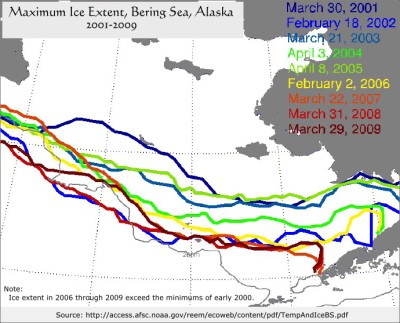
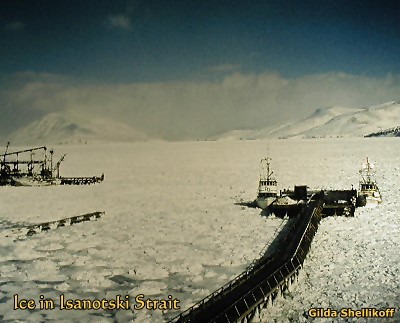
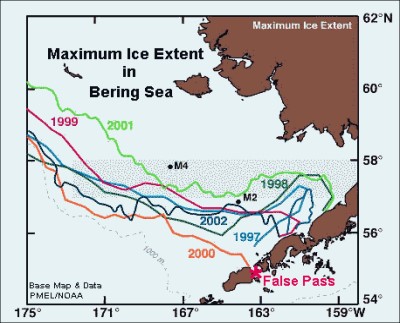
The area of sea ice in the Bering Sea is plotted on the graph to the right, from the year 1979 to mid-April 2012. This work is being done at the University of Illinois/Urbana-Champaign at the Polar Research Group/ Dept. of Atmospheric Sciences. Their website on "The Cryosphere Today" can be accessed here and it contains the most up-to-date information on ice in the Bering Sea, the Beaufort Sea and other world sea ice areas.
The graph shows that the area of ice in the Bering Sea often fluctuates substantially from the 1979-2008 mean, usually in the range of about +-10 to 25%. Even though global warming would suggest a reduced ice pack in 2012, the ice area is an anomalous record high for the period that began in 1979.
Please click on the graph to see a larger version.
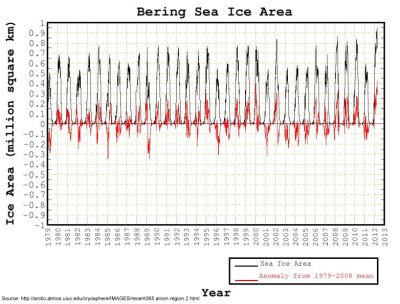
The temperature regime for the Unimak area is documented at the Cold Bay weather station, about 30 miles northeast of False Pass on the Alaska Peninsula.
The strong influence of the marine environment dampens the temperature extremes and daily and seasonal variations. The graph on the right shows that the difference between the average high and average low is roughly 10 degrees.
Precipitation in the Unimak area occurs in all months of the year, there is no dry season. The wettest time of the year is September through December. The days with the heaviest rainfall occurs in the fall, but strong storms can bring southeast winds and heavy rainfall at other times of the year.
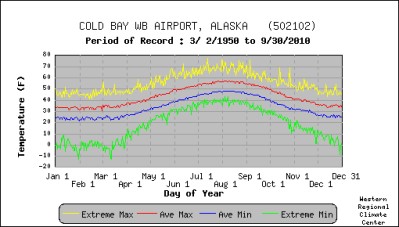
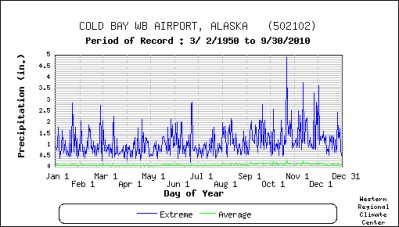
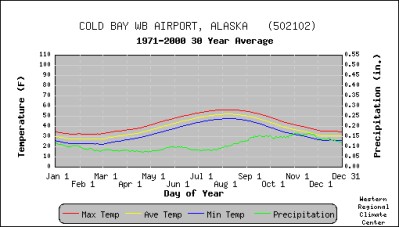
Precipitation falls in every month of the year but is heaviest August through December, as seen in the graph on the right.
Snowfall is very unpredictable and spotty in this maritime environment. The greatest snowdepth is between December and early April although snow often comes and then melts off throughout the winter when the usual mild winter weather prevails. On the other hand, during some winters, the snow comes in November and doesn't melt until April, but this is unusual. Because the Aleutian Low storm track passes very near Unimak Island, many storms bring southeast winds with heavy rain followed by the northerly winds and snow.

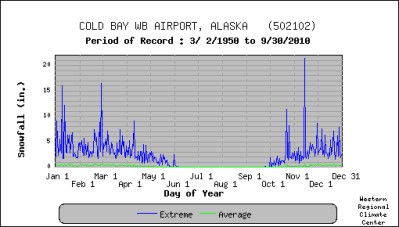
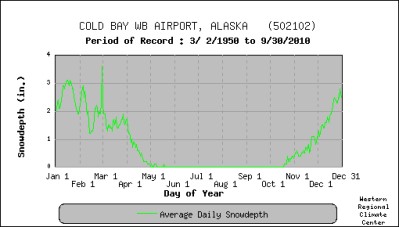
Wind conditions in the Unimak area are the most important weather factor for local fishermen. There is little concern about whether the day will be sunny or cloudy or even rainy, it is the wind that matters most because it determines the safety of traveling by boat or skiff.
The Aleutian Island area has the highest average wind speed of any area in the U.S. Average wind speeds are 15.6 MPH for Cold Bay, with the highest averages from September through May. The summers are relatively quieter, but even then gale force winds usually occur. An old Aleut saying is: "The wind is not a river." This means that the winds will change direction and intensity as a low pressure storm passes by. The storm track almost always leads from the west toward the east along the Aleutian chain. If the storm center passes to the north of Unimak, there is a veering wind shift from SE, to SW, to W, to NW as the storm moves by. If the storm center passes to the south of Unimak, there is a backing wind shift, from SE to E, to NE and finally NW.
Wind gusts over 50 MPH occur 3 or more days per month for 7 months of the year. June is usually the quietest month and December, January and February have 5.0 days each of winds over 50 MPH. The Maximum wind gust during this period was 83 MPH, but every month had gusts of 60 MPH or over.
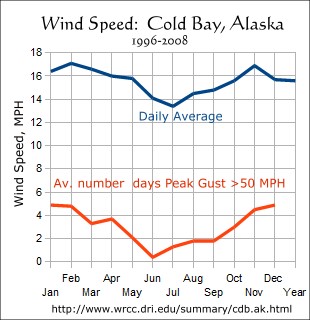
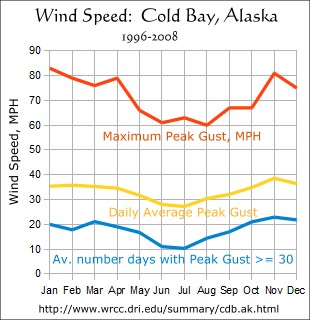
The wind direction is very important to local fishermen and mariners. Since travel and work at sea depends upon favorable wind conditions, wind direction will determine where a fisherman can fish or where he can travel by sea. Calm winds (no direction) in Cold Bay are observed only 2% of the time. The graph to the right shows the mean wind direction frequency in % for Cold Bay, the nearest reporting station.
The two primary wind directions the year around for the Unimak area are southeast and its opposite, northwest. This is because this area is in the storm track of the Aleutian low pressure cells that pass by from west to east with great frequency. As a storm approaches our area from the west, the wind sets in from the southeast and builds in intensity. Then, if the storm passes by to the north of Unimak, the winds veer towards the southwest and then west, and as the storm leaves the area, winds blow from the northwest and then start diminishing. If the storm center passes to the south of Unimak, there is a backing windshift, starting with southeast, then backing to east, northeast and finally northwest as the storm center moves away.
Travel by sea in the Unimak area with its many bays, channels, points and passages is only possible by fishermen when the wind direction and wind intensity are favorable. Certain bays, like Urilia Bay, become unfishable during times of strong westerly winds. Westerlies often occur in the fall, as shown in the wind direction rose for September. Easterly winds are relatively uncommon. Southwest winds are also infrequent, but when they occur they can have great intensity.
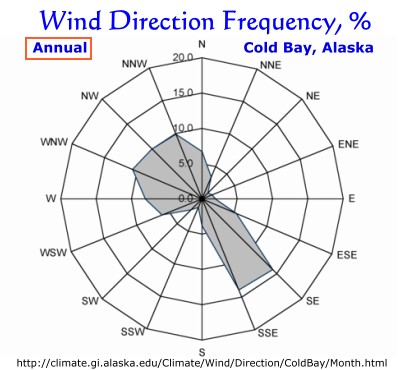
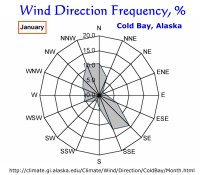
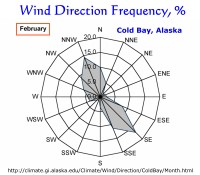
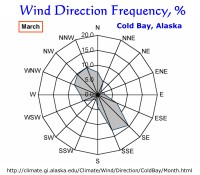
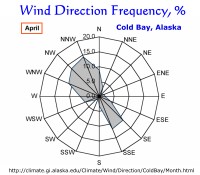
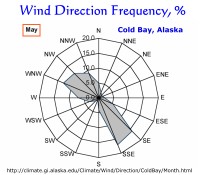
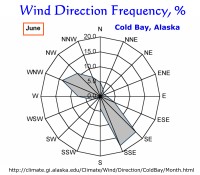
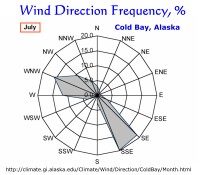
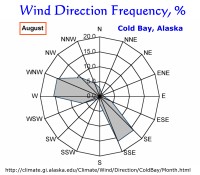
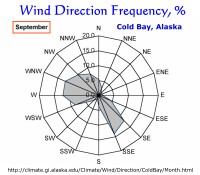
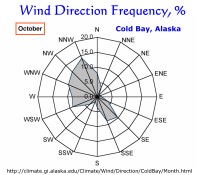
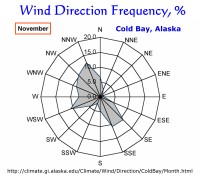
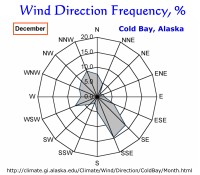
Weather data, both graphic and numeric, for the Unimak area & Cold Bay can be accessed here.
Click here for a numeric table of various weather parameters, including wind, for Cold Bay.
Animated monthly wind direction graphs can be seen here.Weather forecasts for the Unimak area can be accessed on the Internet here.
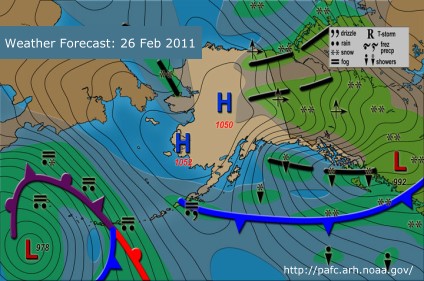

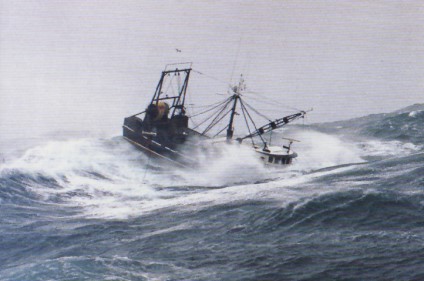
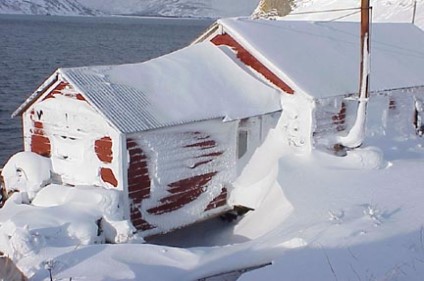
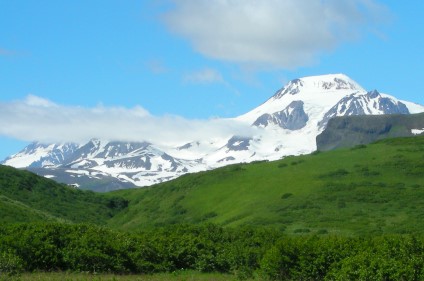

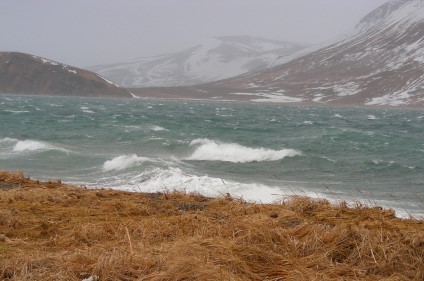
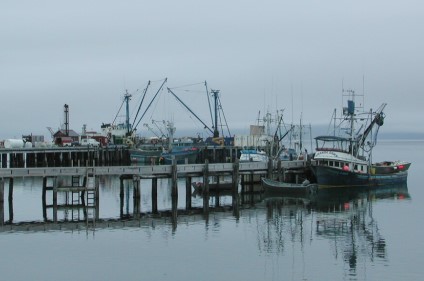
References:
1) http://www.pacificstormsclimatology.org/index.php?page=glossary (NOAA)
2) Hubbard, Bernard R. "Cradle of the Storms", Dodd, Mead & Co, 1935.
3) http://www.arcus.org/synthesis2k/sites/MicaLake/index.php
4) See photo of boat in ice in Ikatan Bay on the False Pass/Isanotski Strait page of this website.
5) Black, Lydia T. "History and Ethnohistory of the Aleutians East Borough", Limestone Press, 1990. (False Pass Chapter)
* Western Regional Climate Center: http://www.wrcc.dri.edu/cgi-bin/cliMAIN.pl?ak2102